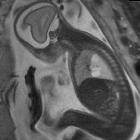paediatric cystic lung lesions
Cystic lesions in pediatric patients are usually congenital lesions and, as such, can be seen antenatally and following delivery.
Pathology
Etiology
Congenital
These congenital lesions are predominantly covered by the overarching diagnosis of bronchopulmonary foregut malformation. This is a heterogeneous group of conditions that result from embryonic foregut maldevelopment and comprises:
- bronchogenic cysts
- bronchopulmonary sequestration
- congenital pulmonary airway malformation (CPAM)
- congenital lobar overinflation (previously called congenital lobar emphysema)
- bronchial atresia
- congenital pulmonary cysts
In addition, conditions outwith this spectrum also cause cystic lung lesions:
It is important to remember that there are other causes of cystic lesions on a chest x-ray, including:
Acquired
Of course, even though the majority of cases are congenital, there are plenty of examples of cystic lung lesions that are acquired:
- pneumatocele: post-pneumonic (Staphylococcus spp.) or following trauma
- infective cavitation: much less common than in adults
- abscess with gas-fluid interface: if the child is supine, the gas at the top of the cavity will have the appearance of a cyst on the chest x-ray
- hydatid disease
- pulmonary interstitial emphysema: a history of neonatal mechanical ventilation or prematurity with respiratory distress syndrome (RDS) will usually be present
Siehe auch:
- Lungensequester
- Bronchogene Zyste
- kongenitale pulmonale Atemwegsmalformation (CPAM)
- Bronchialatresie
- kongenitales lobäres Emphysem
- congenital cystic bronchiectasis
- congenital pulmonary cysts
und weiter:

 Assoziationen und Differentialdiagnosen zu zystische Lungenläsionen bei Kindern:
Assoziationen und Differentialdiagnosen zu zystische Lungenläsionen bei Kindern:kongenitale
pulmonale Atemwegsmalformation (CPAM)





